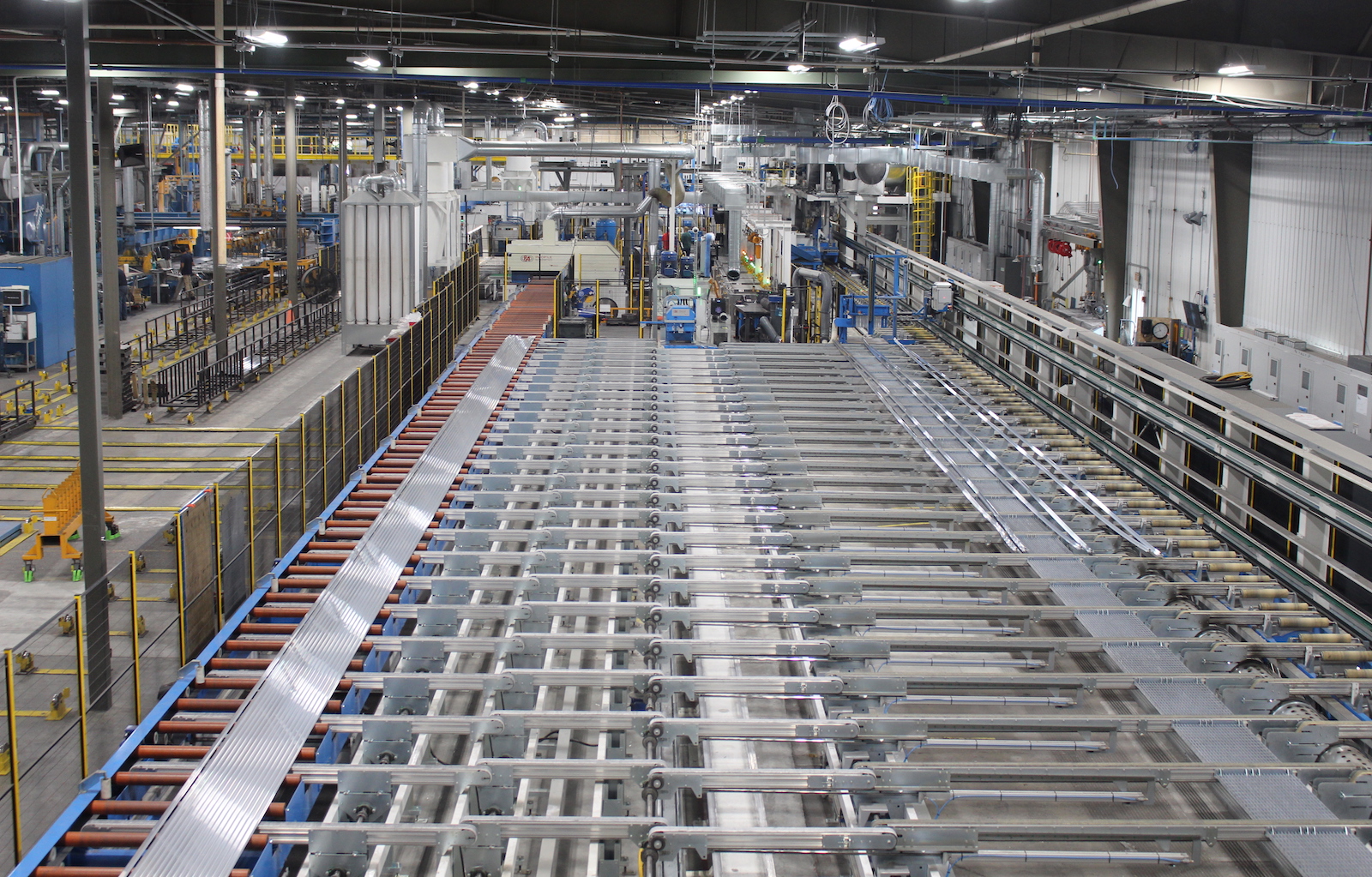
By Andrea Svendsen, Managing Editor.
Alexandria Industries completed an investment project at its operations in Alexandria, MN, where the company has expanded its manufacturing space, installed a new 7 inch, 26 MN front-loading extrusion press line with advanced automation capabilities, and added a new front office and entry. The new press line allows the company to increase its capacity and extrude harder alloys, providing access to new market opportunities, while facing off against market challenges.
“The new press line provides Alexandria Industries with one of the greatest opportunities to grow our extrusion capacities and capabilities,” said Steve Schabel, president at Alexandria. “In particular, the greater level of automation technology in a new press reduces the number of operators we need, which allows us to continue to grow as a company, especially during the current workforce shortages.”
Facing Market Challenges
Established in 1966, Alexandria Industries has grown to be a significant player in the North American aluminum extrusion industry, supplementing its core extrusion business with value-added services, such as machining, fabrication, anodizing, and assembly. The company has five locations across Minnesota, Texas, and Indiana providing an array of services. This includes two extrusion facilities located in Alexandria, MN, and Indianapolis, IN, as well as two machining and fabrication facilities in Alexandria and Carrollton, TX, and a plastics operation in Wheaton, MN.
As with many extrusion companies in the U.S., Alexandria has faced a number of challenges over the past few years, including ongoing issues surrounding the import of underpriced aluminum extrusions from China, dealing with tight aluminum capacities, navigating aluminum pricing and demand, and the COVID-19 pandemic. “Our biggest challenge over the last year is being able to fulfill our workforce needs,” noted Schabel. “Between the number of employees who needed to quarantine because of COVID and the extremely low number of people looking for work, we have had to find creative ways to keep production flowing and bring in the workers we need.”
Despite the number of issues facing the industry, Alexandria has done an admirable job of adjusting to the market climate and weathering these challenges as they occur. “Although the pandemic has wreaked havoc on many American manufacturers, Alexandria Industries has successfully navigated through these turbulent times—enough so that we have continued to be profitable over the past two years and anticipate we will be profitable this year as well,” said Schabel. “Our mantra, ‘Building an ImPRESSive Tomorrow,’ has kept us focused on the positive, especially in a time when unprecedented events have challenged our business in several different ways.”
As the world slowly crawls out of the pandemic, its impact on society and business is evident, as seen in the extrusion industry. “Our capacities are the tightest they have ever been,” said Schabel. “While many markets are thriving, aluminum extruders and metal fabricators are failing at meeting the post COVID-19 demands. These manufacturers are also facing the rising cost of doing business due to services, supplies, and transportation.”
Despite these challenges, demand for aluminum extrusions is currently high, which is driving a number of U.S. extruders to expand and modernize their operations. “Capital investments continue to be made, with the anticipation that the demand will remain at a greater level than in years past,” said Schabel. “Due to the lack of people available to operate equipment, automation is key to growth. Also, extruders across the industry will want a renewed focus on both overall plant safety and employee well-being.”
Project Development
Alexandria made the decision to purchase a new extrusion press in 2019, after realizing that its Loewy press was nearing its end of life. The company found that repairs were proving a major challenge, and this became the driving factor in the decision to purchase a new press.
From start to finish, the new press line project took approximately two years to complete. Alexandria initiated the process by designating a dedicated project manager along with a focused core team that included representation from key functional areas, such as engineering, maintenance, and operations. One of the team’s first steps was to develop detailed equipment specifications, featuring the performance and process capabilities desired by the company. This provided guidelines for all of the potential suppliers.
“We assembled a team to evaluate suppliers capable of providing a system that would meet our needs,” said Tom Welle, strategic initiatives manager, Alexandria Industries. “We then took a two-week excursion across Europe to review different running lines in various facilities in order to determine who could provide the best solution. Price played a role, but it was not the deciding factor.”
After a detailed analysis of all the possibilities, Alexandria signed a contract with Presezzi Extrusion Group in Italy in February 2019, as the supplier was able to provide the most complete solution that met all of the required specifications. The two companies worked closely together to carry out the design and implementation of the project, which faced a number of hurdles along the way.
One of the first challenges involved the limited amount of available space within the facility. Although 19,000 sq ft of manufacturing space was added in order to accommodate the new equipment, the building was still rather narrow. In addition, the old press needed to remain in operation as long as possible while the new press (and additional equipment) was being constructed in order to keep from impacting production.
Therefore, Alexandria and Presezzi implemented the project in phases. The first phase included the installation of the log storage system, the billet heating oven, extrusion press, and run out table with quench and puller. This allowed project teams to run initial tests on the main press systems, while the old press continued to operate. In the second phase, while the remaining equipment was being delivered to Alexandria, the project team worked 24/7 to decommission and remove the old press as quickly as possible, as well as to clean and prepare the foundation. This enabled the second phase to begin, which involved installing the cooling table, stretcher, saws, and stackers. A final phase involved extending the log storage system so that it could also be used by another existing extrusion line within the plant.
The delivery of the first phase of equipment was scheduled to arrive at Alexandria during the middle of winter in Minnesota. This meant that equipment would need to be unloaded and hauled inside at a time when the snow can often be several feet tall. In order to mitigate the risk of delays, the equipment was scheduled to be delivered almost weekly in several shipments with a small quantity of containers.
However, a new challenge arose with the start of the COVID-19 pandemic in early 2020—just as the first containers started to arrive in Minnesota. Travel bans and lockdowns in Italy made it difficult for Presezzi technicians to travel to the U.S. to support the installation process. “The pandemic was a major disrupter, hitting us right before the installation phase of the project,” said Welle. “Shipping delays with the last portion of equipment slowed the start of installation, but we adjusted. Presezzi and the project team had to be creative in getting the correct technical resources onsite to complete the installation and startup.”
Alexandria’s project team worked with the few Presezzi technicians who were able to make the journey along with local companies in order to manage the situation and ensure a safe installation. Once it began, installation and start up of the production line was achieved in less than four weeks, despite the various challenges. “Continual communication both internally and with Presezzi allowed us to identify risks early on,” noted Welle. “This enabled us to modify our actions as needed in order to avoid any major derailment of the project.”
Toward the end of the project, Alexandria’s team developed and utilized a detailed supplier acceptance test in order to ensure that the new line was correctly installed. According to Welle, this test included dozens of factors (including safety, controls, performance, process, and dimensional verifications), which were tested, documented, and approved as part of the acceptance of the line. The new press line was able to pass all of these tests and successfully start operation.
New Press Line
The center point of the new press line is the 7 inch, 26 MN front-loading extrusion press from Presezzi. The press is capable of extruding billet up to 48 inches in length with a working pressure of 3,450 PSI. It is equipped with a PE ESS energy saving system that utilizes a variable speed motor controlled by inverters, which enables it to save energy by up to 30% (compared to a standard hydraulic system). Since the motors are only used when necessary, the press features an additional pump that operates only during the dead cycle in order to achieve an average dead cycle time of below 11.5 seconds.
Personnel safety was a major concern during the design phase of the new press (Figure 1). Therefore, the press is outfitted with a complete safety system, including perimeter fencing along with zoned entry points to allow personnel access into controlled areas once it is safe. In addition, a camera was installed on a 2 inch antiballistic safety door at the press exit, which allows the operator to see the breakthrough of the new profile. An automatic manipulator was also designed to insert the cleaning block into the press, which prevents an operator from needing to get close to the press to do the task.
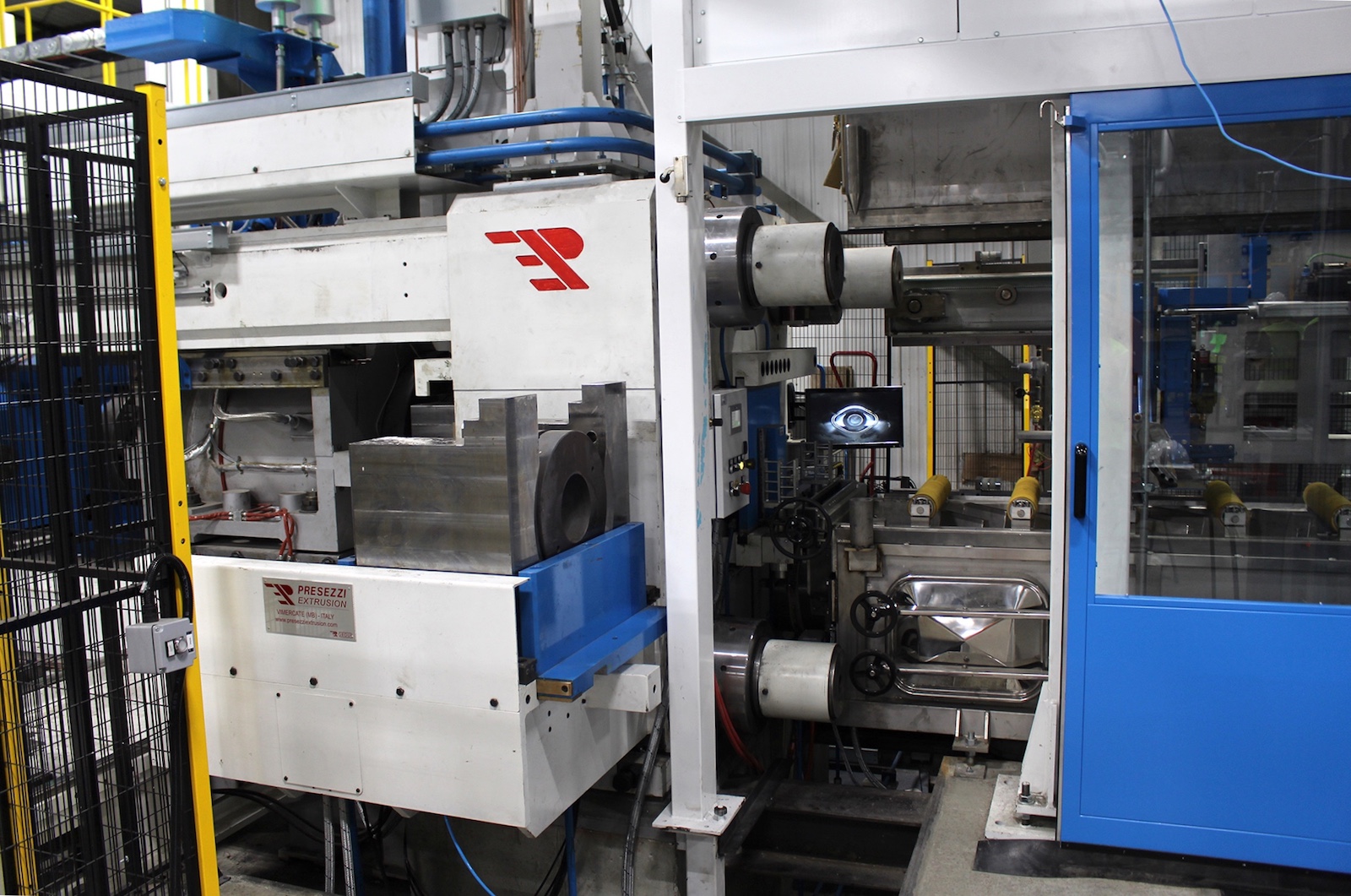
Prior to the press, the new line features advanced log storage, handling, and heating systems. After the logs are unloaded from the delivery truck, they are placed on a loading table where they are manually scanned, making each log traceable. Each log passes through a log linearity test to check for straightness before entering a high-pressure washing machine to remove any superficial contamination. The logs are then automatically placed by crane into the vertical rack system (Figure 2), which is capable of storing more than 500 logs (~500,000 lbs).
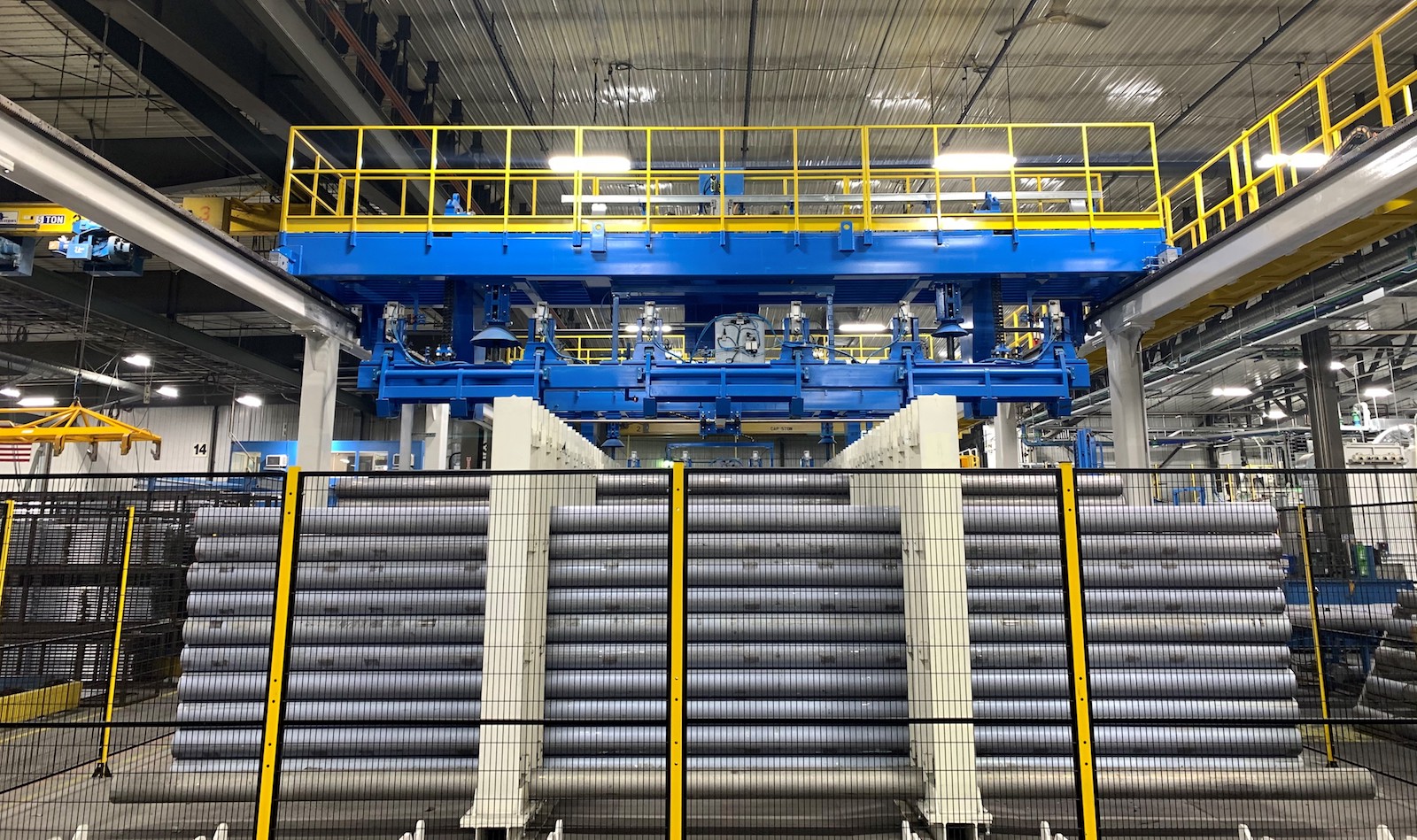
When production begins, the automatic crane will pick up the correct log from storage and deliver it to the cold saw, which cuts it to billet of the correct length required by the press. Following the saw, the line includes dual Zero Pollution Energy (ZPE) magnetic billet heaters, which are able to taper heat the billet up to 250°F (Figure 3). Alexandria selected these ZPE heaters for three reasons. The first is due to the tight spacing requirements of the building, where the smaller heaters would provide a more optimal use of space. Second, Alexandria’s production schedule often requires many alloy changes throughout the day, making it more convenient to heat a single billet at a time, rather than multiple billets in a larger heater. Finally, the ZPEs are said to have a better energy efficiency compared to induction heating systems. “The state-of-the-art, magnetic billet heating system allows us the ability to accurately and cost-effectively heat the aluminum billets prior to extrusion,” said Welle. “We estimate that this feature alone will lower our power consumption by 40%.”
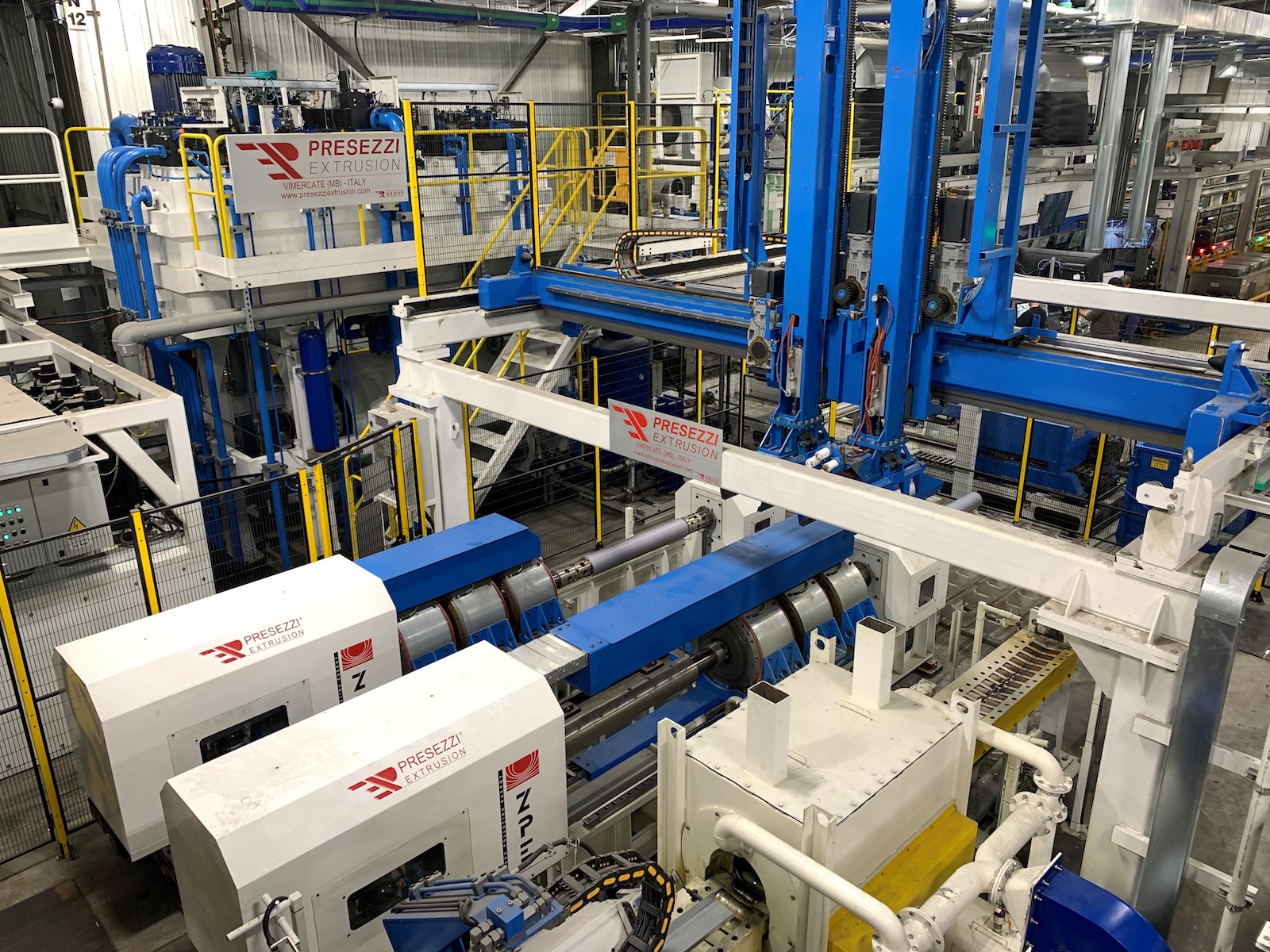
Before being loaded into the press, the extrusion dies are preheated in infra-red die ovens (Figure 4) from Thermika Systems, Inc., based in Canada. The ovens are designed to save energy, decrease operating costs by up to 50%, and reduce die breakage by up to 90%.
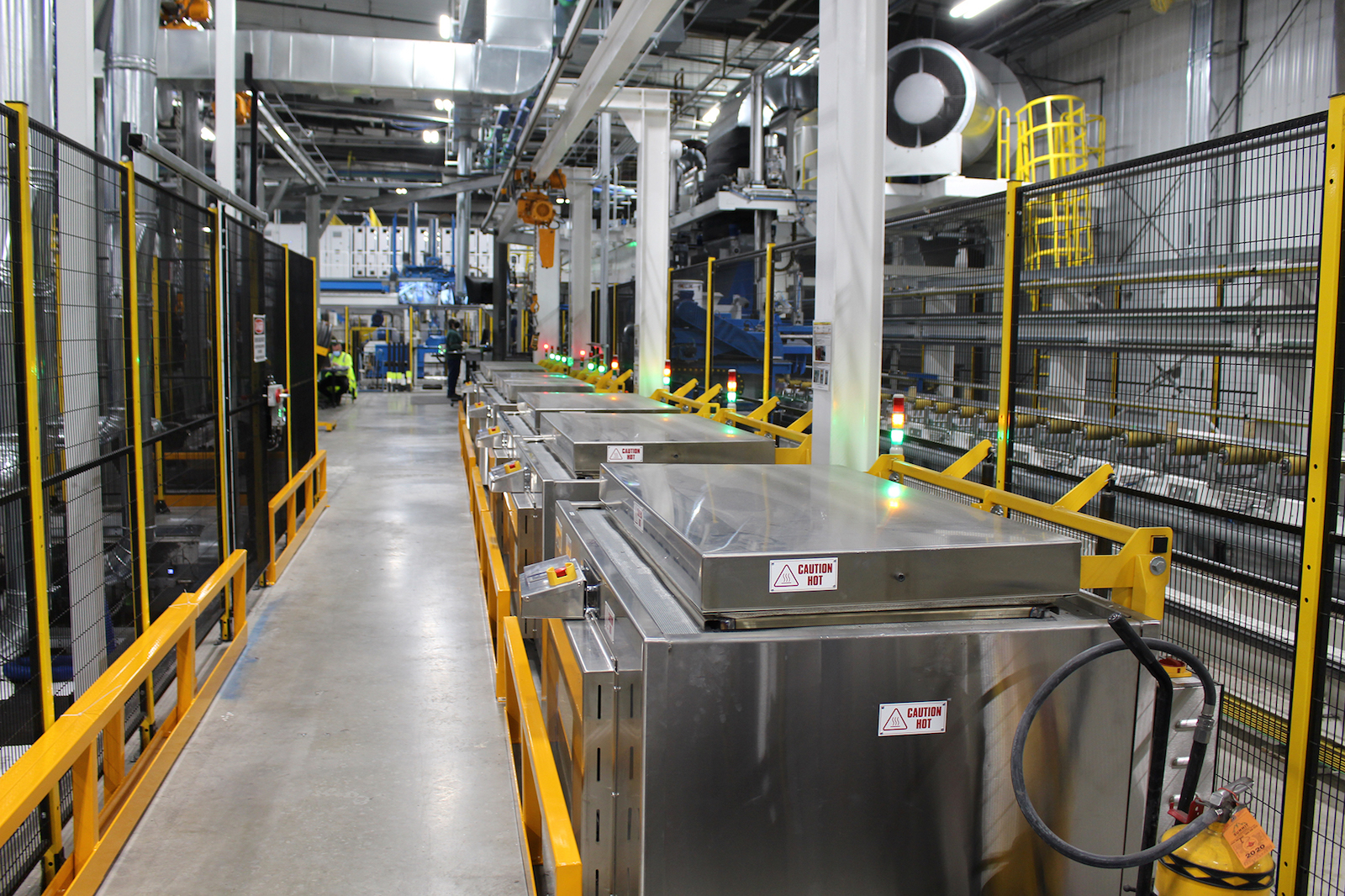
Downstream of the press is a 120 ft lead-out table with an advanced air and water quenching system and a double puller with a flying-cut hot saw. The quench is equipped with 24 rows of nozzles that provide multi-zone cooling and allow for faster cooling with less distortion of the profile. It was designed to allow Alexandria to extrude shapes in a wide variety of aluminum alloys, while providing the mechanical properties and quality required by demanding markets, such as automotive. In addition, a sliding wall installed in the quenching system redirects hot air away from the press operators to help ensure their physical safety (Figure 5).
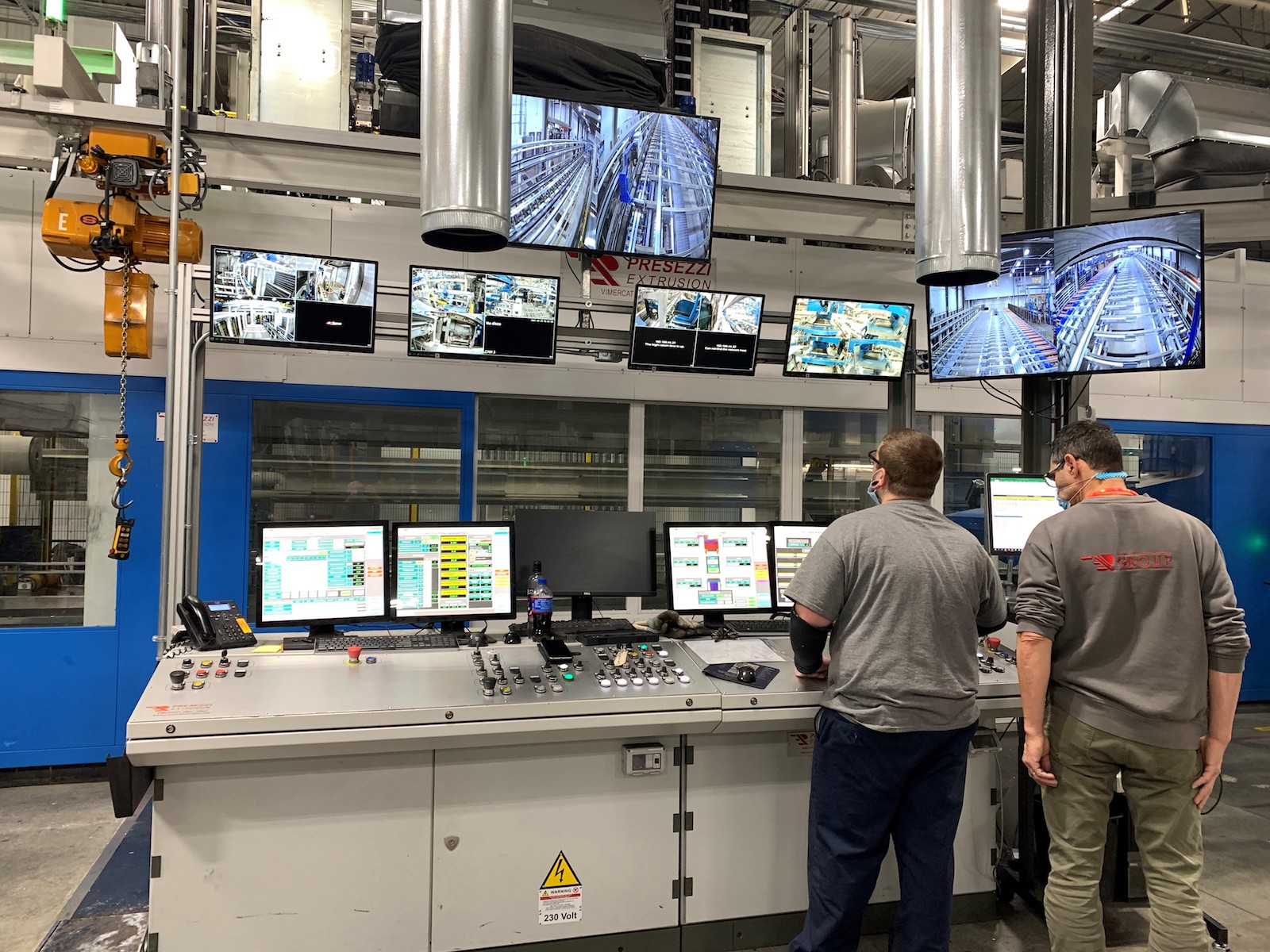
The soft Kevlar handling system also includes a 170 ft long cooling table, a fully automatic 82.5 ton stretcher, dual finishing saws, an automated profile stacker, and an automated scrap chopper and conveyor system. The dual finishing saws are able to perform two cuts of the profile at the same time, achieving precise tolerances (Figure 6). After cutting, profiles are stacked into loads that can be delivered to either the packing area for shipping or to the aging ovens for additional treatment.
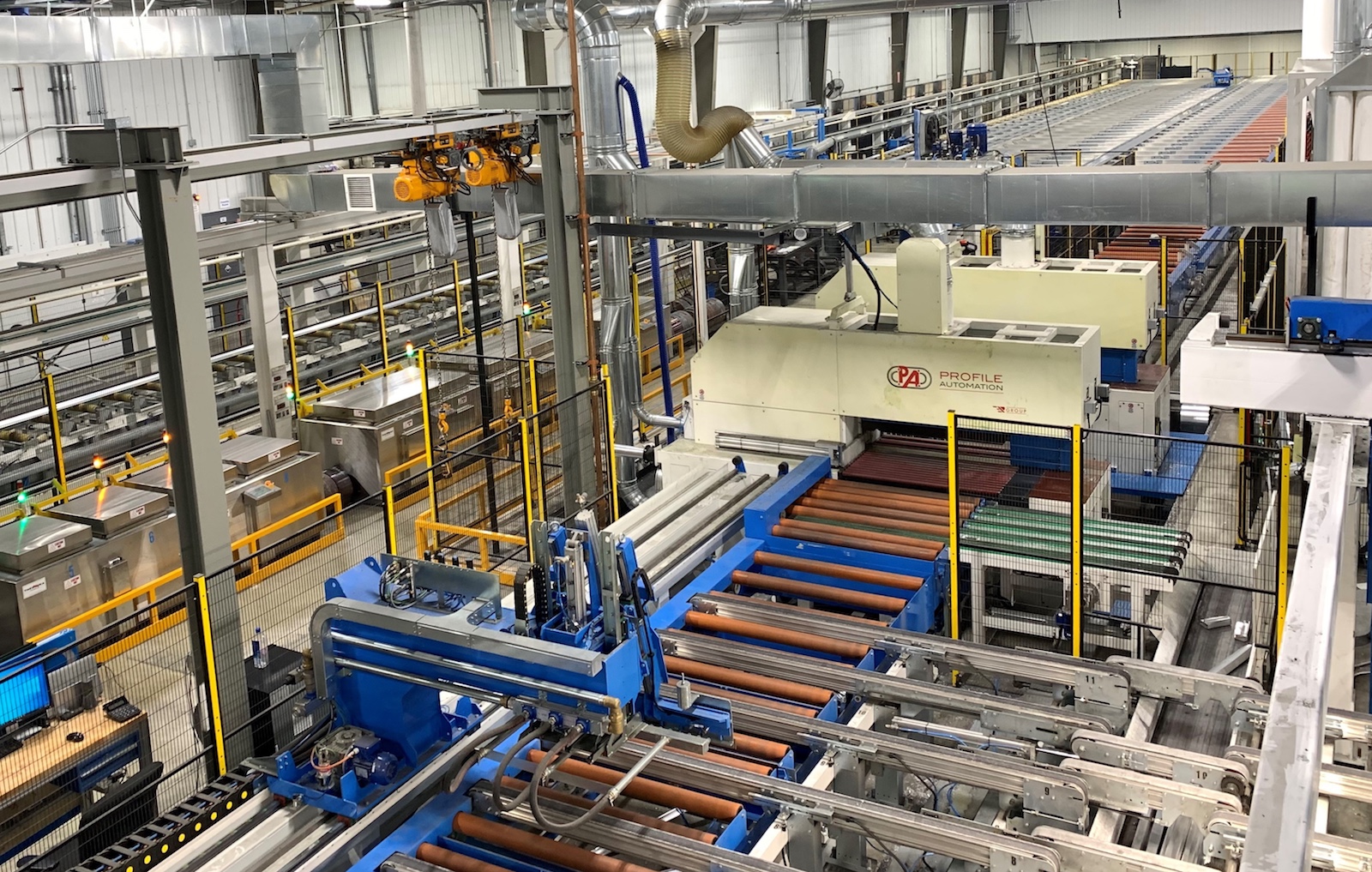
Alexandria recently placed an order for a new aging oven from Belco Industries, Inc., located in Belding, MI, that will soon be installed to absorb the additional production capacity from the new extrusion line. The reversing end-flow aging oven with a powered roller conveyor will be capable of heating aluminum profiles up to 500°F. The oven will be equipped with reversing dampers that control airflow in the furnace. Situated directly opposite each other, the dampers are able to change the direction of the discharge and return air whenever they are rotated 90 degrees. This oven will also feature an Allen Bradley PLC system with recipe control. Belco designed this oven to meet the ASTM B918 standard for heat treating.
“We set out to install a press line that could be completely run with a predetermined number of operators,” noted Welle. “Automation throughout the extrusion line was important in this effort. It was also important for the safety of our operators and gives us the opportunity to increase extrusion production by around 30%.”
Investing in Personnel
In starting the new press line project, Alexandria knew it would be important to include training as part of the overall process. “We started the training process early by sharing the operations and maintenance manuals with our teams,” said Welle. “In that way, they could get an early understanding of the equipment before actually seeing it. We also use current operators and support staff to train others, when possible.” In addition, Presezzi technicians provided onsite training during start up and commissioning of the press, as well as continuing to provide support as needed.
As the company moves forward with its new line, labor availability remains one of its greatest challenges. “Baby boomers—many tenured 20, 30, and 40+ year employees—are retiring at a higher rate than usual,” explained Schabel. “There are just not enough students entering into the mechanical trades and manufacturing to backfill these openings.”
One of the ways in which Alexandria is working to address these labor challenges is by supporting employees in their development as much as possible. To that end, the company provides leadership development programs and training for talented team members who are looking to advance themselves and the organization. In addition, the company continues to build on its robust safety programs in order to ensure employee safety and well-being, as well as building and creating environments that foster quality work. “As an organization, we reinvest in our employees, the environment they work in, and the technology they use to make our customers’ products,” explained Schabel. “We have always run our business this way and we intend to always run our business this way. Our employees and customers become the ultimate beneficiaries of this business model.”
Editor’s Note: This article first appeared in the August 2021 issue of Light Metal Age. To receive the current issue, please subscribe.
